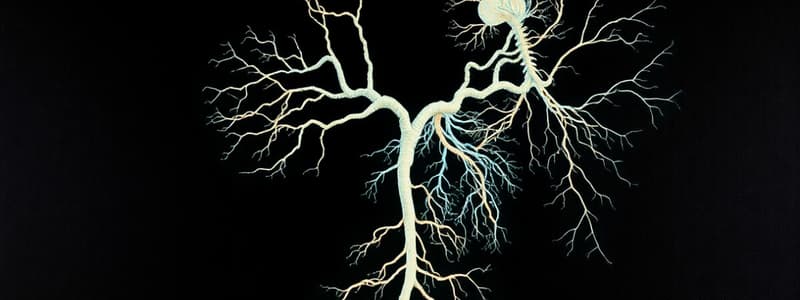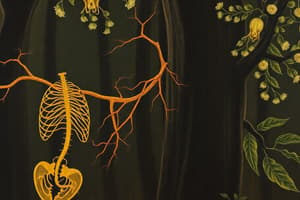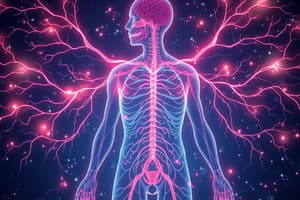Podcast
Questions and Answers
What type of receptors are typically found in sweat glands?
What type of receptors are typically found in sweat glands?
- Nicotinic receptors
- Adrenergic receptors
- M3 muscarinic receptors (correct)
- Alpha adrenergic receptors
What is the primary function of nicotinic receptors at the neuromuscular junction?
What is the primary function of nicotinic receptors at the neuromuscular junction?
- Inhibit muscle contraction
- Facilitate slow depolarization
- Assemble lipid membranes
- Facilitate rapid depolarization (correct)
Which adrenergic receptor subtype has a greater affinity for noradrenaline?
Which adrenergic receptor subtype has a greater affinity for noradrenaline?
- Beta-2
- Beta-1
- Alpha-2
- Alpha-1 (correct)
Which signaling pathway is activated by M2 muscarinic receptors?
Which signaling pathway is activated by M2 muscarinic receptors?
What is the role of chromaffin cells within the adrenal medulla in the sympathetic nervous system?
What is the role of chromaffin cells within the adrenal medulla in the sympathetic nervous system?
Which of the following best describes G-protein coupled receptors?
Which of the following best describes G-protein coupled receptors?
Which neurotransmitter is primarily associated with adrenergic receptors?
Which neurotransmitter is primarily associated with adrenergic receptors?
What characterizes the N2 or Nn subtype of nicotinic receptors?
What characterizes the N2 or Nn subtype of nicotinic receptors?
Which neurotransmitter is primarily released by post-ganglionic sympathetic neurons to act on adrenergic receptors?
Which neurotransmitter is primarily released by post-ganglionic sympathetic neurons to act on adrenergic receptors?
What type of receptors do pre-ganglionic neurons in both the sympathetic and parasympathetic systems activate on post-ganglionic neurons?
What type of receptors do pre-ganglionic neurons in both the sympathetic and parasympathetic systems activate on post-ganglionic neurons?
Which adrenergic receptor subtype is primarily responsible for causing vasoconstriction in the gastrointestinal tract?
Which adrenergic receptor subtype is primarily responsible for causing vasoconstriction in the gastrointestinal tract?
Which of the following is NOT a function of β2 adrenergic receptors?
Which of the following is NOT a function of β2 adrenergic receptors?
What is the primary mechanism by which noradrenaline exerts a negative feedback effect in adrenergic transmission?
What is the primary mechanism by which noradrenaline exerts a negative feedback effect in adrenergic transmission?
What effect does ATP have when binding to P2X receptors on smooth muscle cells?
What effect does ATP have when binding to P2X receptors on smooth muscle cells?
What is one effect of co-transmission of noradrenaline and ATP in sympathetic post-ganglionic neurons?
What is one effect of co-transmission of noradrenaline and ATP in sympathetic post-ganglionic neurons?
Which type of adrenergic receptor is associated with increased cardiac muscle contractility?
Which type of adrenergic receptor is associated with increased cardiac muscle contractility?
What role does the calcium influx play during adrenergic signaling when noradrenaline binds to α1 receptors?
What role does the calcium influx play during adrenergic signaling when noradrenaline binds to α1 receptors?
Which of the following best describes the primary function of the sympathetic nervous system?
Which of the following best describes the primary function of the sympathetic nervous system?
What is a key structural difference between the parasympathetic and sympathetic nervous systems?
What is a key structural difference between the parasympathetic and sympathetic nervous systems?
Which response accurately represents the effect of the parasympathetic nervous system on the heart?
Which response accurately represents the effect of the parasympathetic nervous system on the heart?
During the fight or flight response, which of the following physiological changes occurs?
During the fight or flight response, which of the following physiological changes occurs?
Which neurotransmitter is primarily associated with the sympathetic nervous system's response?
Which neurotransmitter is primarily associated with the sympathetic nervous system's response?
What is the general role of afferent neurons within the autonomic nervous system?
What is the general role of afferent neurons within the autonomic nervous system?
Which of the following statements about the autonomic nervous system is incorrect?
Which of the following statements about the autonomic nervous system is incorrect?
In terms of receptor types and functions, which statement is accurate regarding the effects of the sympathetic nervous system?
In terms of receptor types and functions, which statement is accurate regarding the effects of the sympathetic nervous system?
Which aspect of neurotransmitter co-transmission typically occurs in the autonomic nervous system?
Which aspect of neurotransmitter co-transmission typically occurs in the autonomic nervous system?
Which statement correctly describes the neuroendocrine functions associated with the sympathetic nervous system?
Which statement correctly describes the neuroendocrine functions associated with the sympathetic nervous system?
Match the following glands with their primary function:
Match the following glands with their primary function:
Match the following structures with their role in the autonomic nervous system:
Match the following structures with their role in the autonomic nervous system:
Match the division of the nervous system with its primary characteristics:
Match the division of the nervous system with its primary characteristics:
Match the following types of smooth muscle with their characteristics:
Match the following types of smooth muscle with their characteristics:
Match the following terms with their definitions in the context of the ANS:
Match the following terms with their definitions in the context of the ANS:
Match the type of neuron with its function:
Match the type of neuron with its function:
Match the autonomic nervous system branch with its function:
Match the autonomic nervous system branch with its function:
Match the following components of autonomic ganglia with their function:
Match the following components of autonomic ganglia with their function:
Match the following features with their corresponding types of axon terminals:
Match the following features with their corresponding types of axon terminals:
Match the physiological response with the appropriate nervous system branch:
Match the physiological response with the appropriate nervous system branch:
Match the following responses with their appropriate stimuli in the autonomic nervous system:
Match the following responses with their appropriate stimuli in the autonomic nervous system:
Match the anatomical feature with the autonomic nervous system:
Match the anatomical feature with the autonomic nervous system:
Match the following types of neurons with their functions:
Match the following types of neurons with their functions:
Match the term with its correct description in the autonomic nervous system:
Match the term with its correct description in the autonomic nervous system:
Match the following phrases with their correct descriptions in neural signaling:
Match the following phrases with their correct descriptions in neural signaling:
Match the type of response with the respective organ activation:
Match the type of response with the respective organ activation:
Match the characteristic of the autonomic nervous system with its division:
Match the characteristic of the autonomic nervous system with its division:
Match the type of physiological change with its occurring scenario:
Match the type of physiological change with its occurring scenario:
Match the types of smooth muscle to their characteristics:
Match the types of smooth muscle to their characteristics:
Match the neurotransmitter with its corresponding action in the autonomic nervous system:
Match the neurotransmitter with its corresponding action in the autonomic nervous system:
Match the adrenergic receptor subtype with its primary effect:
Match the adrenergic receptor subtype with its primary effect:
Match the types of neurotransmitter receptors to their descriptions:
Match the types of neurotransmitter receptors to their descriptions:
Match the component of adrenergic signaling with its description:
Match the component of adrenergic signaling with its description:
Match the neurotransmitter types with their associated nervous system:
Match the neurotransmitter types with their associated nervous system:
Match the receptor type with its location:
Match the receptor type with its location:
Match the processes involved in cholinergic transmission:
Match the processes involved in cholinergic transmission:
Match the process with its corresponding neurotransmitter action:
Match the process with its corresponding neurotransmitter action:
Match the components of ganglion cell innervation:
Match the components of ganglion cell innervation:
Match the effect with the relevant adrenergic receptors:
Match the effect with the relevant adrenergic receptors:
Match the effects of ACh when released in the synaptic cleft:
Match the effects of ACh when released in the synaptic cleft:
Match the types of adrenergic signalling to their neurotransmitters:
Match the types of adrenergic signalling to their neurotransmitters:
Match the type of receptor with its mechanism of action:
Match the type of receptor with its mechanism of action:
Match the physiological effects with the receptor subtype:
Match the physiological effects with the receptor subtype:
Match the neurotransmitter with its storage site:
Match the neurotransmitter with its storage site:
Match the type of autonomic fiber with its corresponding characteristic:
Match the type of autonomic fiber with its corresponding characteristic:
Match the roles of neurotransmitters with their definitions:
Match the roles of neurotransmitters with their definitions:
Match the neurotransmitter with its effect on receptor types:
Match the neurotransmitter with its effect on receptor types:
Match the following types of receptors with their characteristics:
Match the following types of receptors with their characteristics:
Match the following subtypes of nicotinic receptors with their locations:
Match the following subtypes of nicotinic receptors with their locations:
Match the following adrenergic receptor types with their greater affinity:
Match the following adrenergic receptor types with their greater affinity:
Match the following muscarinic receptor subtypes with their signaling pathways:
Match the following muscarinic receptor subtypes with their signaling pathways:
Match the following physiological effects with the corresponding receptors:
Match the following physiological effects with the corresponding receptors:
Match the following neurotransmitters with their corresponding receptors:
Match the following neurotransmitters with their corresponding receptors:
Match the following components of the sympathetic nervous system with their functions:
Match the following components of the sympathetic nervous system with their functions:
Match the following receptor functions to their effects:
Match the following receptor functions to their effects:
Study Notes
The Autonomic Nervous System (ANS)
- The autonomic nervous system (ANS) unconsciously controls intrinsic processes such as breathing and digestion.
- The ANS is divided into two branches: the sympathetic nervous system and the parasympathetic nervous system.
- The sympathetic nervous system is responsible for the "fight or flight" response, activating the body for stressful situations.
- The parasympathetic nervous system is responsible for the "rest and digest" response, calming the body and regulating internal functions.
- The sympathetic nervous system originates from the thoracic and lumbar regions of the spinal cord, whereas the parasympathetic nervous system originates from the brainstem and sacral region of the spinal cord.
Anatomical Differences
- In the sympathetic system, pre-ganglionic axons are short and post-ganglionic axons are long, while in the parasympathetic system, pre-ganglionic axons are long and post-ganglionic axons are short.
- Sympathetic ganglia are located closer to the spinal cord while parasympathetic ganglia are located close to the innervated organ.
Organ Responses
- Heart: The sympathetic nervous system increases heart rate and force of contraction, while the parasympathetic nervous system decreases both.
- Pupils: The sympathetic nervous system dilates pupils, increasing the field of vision, while the parasympathetic nervous system constricts pupils, allowing for better focus.
- Digestive System: The sympathetic nervous system decreases digestive activity, diverting energy to the muscles, while the parasympathetic nervous system increases digestive activity, preparing the body for nutrient absorption.
- Blood Vessels: The sympathetic nervous system generally causes vasoconstriction, diverting blood to the muscles and heart, while the parasympathetic nervous system has a limited effect on blood vessels.
- Sweat Glands: The sympathetic nervous system activates sweat glands, increasing perspiration to cool the body.
- Salivary Glands: The sympathetic nervous system decreases saliva production, while the parasympathetic nervous system increases saliva production.
Neurotransmitters: Acetylcholine (ACh), Norepinephrine (NA), and Epinephrine (A)
- Acetylcholine (ACh): The primary neurotransmitter used by the parasympathetic nervous system. It is also used by all preganglionic neurons in both sympathetic and parasympathetic systems.
- Norepinephrine (NA): The primary neurotransmitter used by the sympathetic nervous system (postganglionic fibers). It is also released by the adrenal medulla into the bloodstream.
- Epinephrine (A): Also known as adrenaline, is released by the adrenal medulla into the bloodstream.
Receptors:
- Nicotinic receptors: Found at the neuromuscular junction and on postganglionic neurons. They are stimulated by acetylcholine and are ligand-gated ion channels.
- Muscarinic receptors: Found on target organs, stimulated by acetylcholine. They are G-protein coupled receptors, and different subtypes produce different effects.
- Alpha receptors (α1 and α2): Primarily activated by norepinephrine. They are found on smooth muscle, the heart, and other tissues.
- Beta receptors (β1, β2, and β3 ): Primarily activated by epinephrine. They are found on various tissues and can affect heart rate, blood pressure, and metabolism.
Adrenergic Transmission
- Synthesis: Tyrosine is converted into dopamine, which is then converted into norepinephrine.
- Release: When an action potential arrives at the nerve ending, calcium ions enter the terminal, triggering the release of norepinephrine from vesicles.
- Receptor Activation: Norepinephrine acts on α and β receptors on target organs.
- Feedback Mechanism: Norepinephrine also binds to α2 receptors on the presynaptic neuron, inhibiting further release of norepinephrine (negative feedback).
Co-transmission
- Sympathetic neurons also release ATP alongside norepinephrine. ATP acts on P2X and P2Y receptors on target organs.
- ATP acts faster than norepinephrine, causing a rapid contraction of smooth muscles.
- ATP also acts on presynaptic receptors to inhibit the release of both norepinephrine and ATP.
Exceptions
- Some organs, notably blood vessels, sweat glands, and salivary glands, are mostly innervated by the sympathetic nervous system.
Key Points to Remember
- The sympathetic nervous system is responsible for mobilizing the body in stressful situations, while the parasympathetic nervous system is responsible for calming the body and conserving energy.
- The specific effects of the ANS depend on the target organ and the types of receptors present.
- Both the sympathetic and parasympathetic nervous systems utilize neurotransmitter signaling to influence target organ function.
Studying That Suits You
Use AI to generate personalized quizzes and flashcards to suit your learning preferences.
Related Documents
Description
Explore the intricacies of the autonomic nervous system (ANS) and its two primary branches: the sympathetic and parasympathetic systems. Understand how these systems manage vital processes like digestion and stress responses through their unique anatomical structures and functions.



